语言学各章复习重点
- 格式:docx
- 大小:19.14 KB
- 文档页数:3
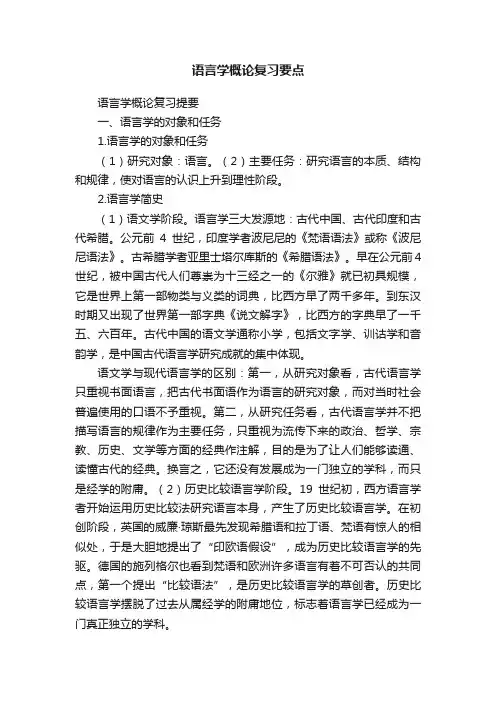
语言学概论复习要点语言学概论复习提要一、语言学的对象和任务1.语言学的对象和任务(1)研究对象:语言。
(2)主要任务:研究语言的本质、结构和规律,使对语言的认识上升到理性阶段。
2.语言学简史(1)语文学阶段。
语言学三大发源地:古代中国、古代印度和古代希腊。
公元前4世纪,印度学者波尼尼的《梵语语法》或称《波尼尼语法》。
古希腊学者亚里士塔尔库斯的《希腊语法》。
早在公元前4世纪,被中国古代人们尊崇为十三经之一的《尔雅》就已初具规模,它是世界上第一部物类与义类的词典,比西方早了两千多年。
到东汉时期又出现了世界第一部字典《说文解字》,比西方的字典早了一千五、六百年。
古代中国的语文学通称小学,包括文字学、训诂学和音韵学,是中国古代语言学研究成就的集中体现。
语文学与现代语言学的区别:第一,从研究对象看,古代语言学只重视书面语言,把古代书面语作为语言的研究对象,而对当时社会普遍使用的口语不予重视。
第二,从研究任务看,古代语言学并不把描写语言的规律作为主要任务,只重视为流传下来的政治、哲学、宗教、历史、文学等方面的经典作注解,目的是为了让人们能够读通、读懂古代的经典。
换言之,它还没有发展成为一门独立的学科,而只是经学的附庸。
(2)历史比较语言学阶段。
19世纪初,西方语言学者开始运用历史比较法研究语言本身,产生了历史比较语言学。
在初创阶段,英国的威廉·琼斯最先发现希腊语和拉丁语、梵语有惊人的相似处,于是大胆地提出了“印欧语假设”,成为历史比较语言学的先驱。
德国的施列格尔也看到梵语和欧洲许多语言有着不可否认的共同点,第一个提出“比较语法”,是历史比较语言学的草创者。
历史比较语言学摆脱了过去从属经学的附庸地位,标志着语言学已经成为一门真正独立的学科。
历史比较语言学由于涉及多种语言,这为普通语言学的创立奠定了基础。
19世纪中叶,从理论上研究人类语言一般规律的普通语言学诞生。
奠基人是德国的洪堡特和瑞士的索绪尔。
洪堡特被公认为普通语言学的第一个奠基者,他的许多语言学观点被后代学者不断继承和发展。
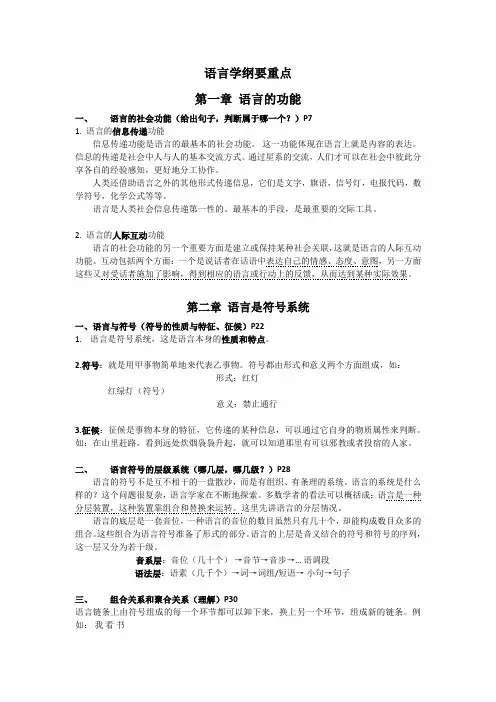
语言学纲要重点第一章语言的功能一、语言的社会功能(给出句子,判断属于哪一个?)P71. 语言的信息传递功能信息传递功能是语言的最基本的社会功能。
这一功能体现在语言上就是内容的表达。
信息的传递是社会中人与人的基本交流方式。
通过星系的交流,人们才可以在社会中彼此分享各自的经验感知,更好地分工协作。
人类还借助语言之外的其他形式传递信息,它们是文字,旗语,信号灯,电报代码,数学符号,化学公式等等。
语言是人类社会信息传递第一性的、最基本的手段,是最重要的交际工具。
2. 语言的人际互动功能语言的社会功能的另一个重要方面是建立或保持某种社会关联,这就是语言的人际互动功能。
互动包括两个方面:一个是说话者在话语中表达自己的情感、态度、意图,另一方面这些又对受话者施加了影响,得到相应的语言或行动上的反馈,从而达到某种实际效果。
第二章语言是符号系统一、语言与符号(符号的性质与特征、征候)P221.语言是符号系统,这是语言本身的性质和特点。
2.符号:就是用甲事物简单地来代表乙事物。
符号都由形式和意义两个方面组成,如:形式:红灯红绿灯(符号)意义:禁止通行3.征候:征候是事物本身的特征,它传递的某种信息,可以通过它自身的物质属性来判断。
如:在山里赶路,看到远处炊烟袅袅升起,就可以知道那里有可以邪教或者投宿的人家。
二、语言符号的层级系统(哪几层,哪几级?)P28语言的符号不是互不相干的一盘散沙,而是有组织、有条理的系统。
语言的系统是什么样的?这个问题很复杂,语言学家在不断地探索。
多数学者的看法可以概括成:语言是一种分层装置,这种装置靠组合和替换来运转。
这里先讲语言的分层情况。
语言的底层是一套音位,一种语言的音位的数目虽然只有几十个,却能构成数目众多的组合。
这些组合为语言符号准备了形式的部分。
语言的上层是音义结合的符号和符号的序列,这一层又分为若干级。
音系层:音位(几十个)→音节→音步→…语调段语法层:语素(几千个)→词→词组/短语→小句→句子三、组合关系和聚合关系(理解)P30语言链条上由符号组成的每一个环节都可以卸下来,换上另一个环节,组成新的链条。
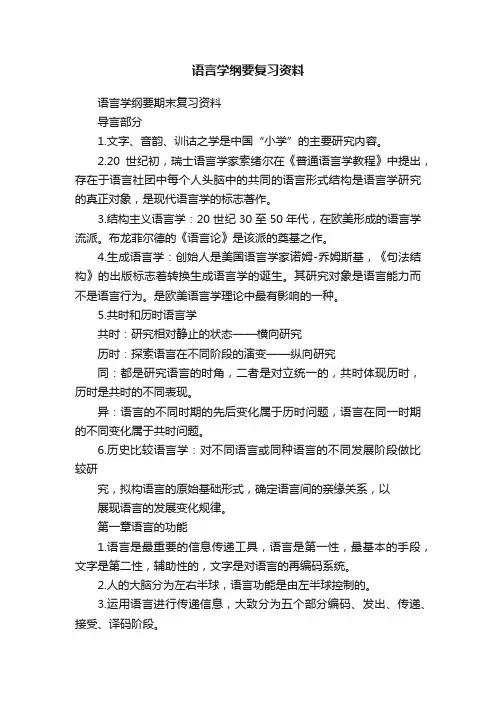
语言学纲要复习资料语言学纲要期末复习资料导言部分1.文字、音韵、训诂之学是中国“小学”的主要研究内容。
2.20世纪初,瑞士语言学家索绪尔在《普通语言学教程》中提出,存在于语言社团中每个人头脑中的共同的语言形式结构是语言学研究的真正对象,是现代语言学的标志著作。
3.结构主义语言学:20世纪30至50年代,在欧美形成的语言学流派。
布龙菲尔德的《语言论》是该派的奠基之作。
4.生成语言学:创始人是美国语言学家诺姆-乔姆斯基,《句法结构》的出版标志着转换生成语言学的诞生。
其研究对象是语言能力而不是语言行为。
是欧美语言学理论中最有影响的一种。
5.共时和历时语言学共时:研究相对静止的状态——横向研究历时:探索语言在不同阶段的演变——纵向研究同:都是研究语言的时角,二者是对立统一的,共时体现历时,历时是共时的不同表现。
异:语言的不同时期的先后变化属于历时问题,语言在同一时期的不同变化属于共时问题。
6.历史比较语言学:对不同语言或同种语言的不同发展阶段做比较研究,拟构语言的原始基础形式,确定语言间的亲缘关系,以展现语言的发展变化规律。
第一章语言的功能1.语言是最重要的信息传递工具,语言是第一性,最基本的手段,文字是第二性,辅助性的,文字是对语言的再编码系统。
2.人的大脑分为左右半球,语言功能是由左半球控制的。
3.运用语言进行传递信息,大致分为五个部分编码、发出、传递、接受、译码阶段。
4.思维方式的差异更多地体现在不同语言在表达思想时语法方面的特点。
5.思维能力的普遍性和思维方式的特殊性,与语言的性质是密切相关的。
6.语言和言语的区分是索绪尔提出的,言语不稳定,语言是稳定的。
7.语言是符号系统,是最重要最典型的符号,符号的形式和意义是约定,无必然联系。
征候是事物本身的特征,它传递的某种信息,可以通过它自身的物质属性来推断。
(远处的炊烟、病人的脉象、气色、舌苔、口气,罪犯的指纹,脚印)8.音————义————心理现实————客观现实语言符号指称反映客观现实:是四维时空中外在于人的所有存在,当下和历史上所有的人物、事物、现象以及他们的相互关系及其变化。
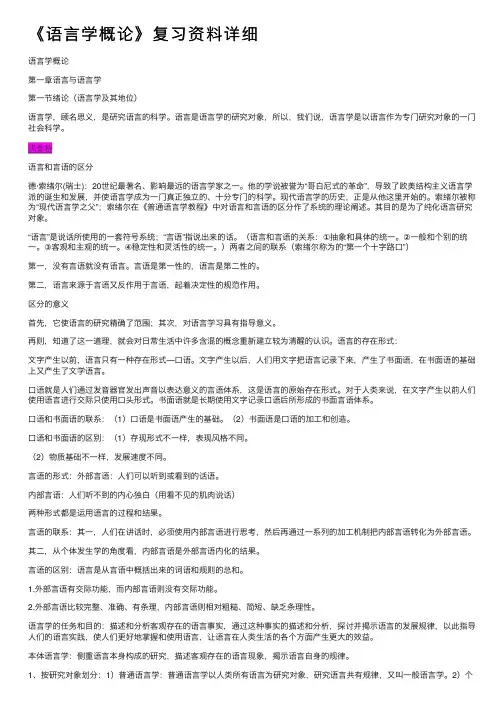
《语⾔学概论》复习资料详细语⾔学概论第⼀章语⾔与语⾔学第⼀节绪论(语⾔学及其地位)语⾔学,顾名思义,是研究语⾔的科学。
语⾔是语⾔学的研究对象,所以,我们说,语⾔学是以语⾔作为专门研究对象的⼀门社会科学。
语⾔和⾔语的区分德·索绪尔(瑞⼠):20世纪最著名、影响最远的语⾔学家之⼀。
他的学说被誉为“哥⽩尼式的⾰命”,导致了欧美结构主义语⾔学派的诞⽣和发展,并使语⾔学成为⼀门真正独⽴的、⼗分专门的科学。
现代语⾔学的历史,正是从他这⾥开始的。
索绪尔被称为“现代语⾔学之⽗”;索绪尔在《普通语⾔学教程》中对语⾔和⾔语的区分作了系统的理论阐述。
其⽬的是为了纯化语⾔研究对象。
“语⾔”是说话所使⽤的⼀套符号系统;“⾔语”指说出来的话。
(语⾔和⾔语的关系:①抽象和具体的统⼀。
②⼀般和个别的统⼀。
③客观和主观的统⼀。
④稳定性和灵活性的统⼀。
)两者之间的联系(索绪尔称为的“第⼀个⼗字路⼝”)第⼀,没有⾔语就没有语⾔。
⾔语是第⼀性的,语⾔是第⼆性的。
第⼆,语⾔来源于⾔语⼜反作⽤于⾔语,起着决定性的规范作⽤。
区分的意义⾸先,它使语⾔的研究精确了范围;其次,对语⾔学习具有指导意义。
再则,知道了这⼀道理,就会对⽇常⽣活中许多含混的概念重新建⽴较为清醒的认识。
语⾔的存在形式:⽂字产⽣以前,语⾔只有⼀种存在形式—⼝语。
⽂字产⽣以后,⼈们⽤⽂字把语⾔记录下来,产⽣了书⾯语,在书⾯语的基础上⼜产⽣了⽂学语⾔。
⼝语就是⼈们通过发⾳器官发出声⾳以表达意义的⾔语体系,这是语⾔的原始存在形式。
对于⼈类来说,在⽂字产⽣以前⼈们使⽤语⾔进⾏交际只使⽤⼝头形式。
书⾯语就是长期使⽤⽂字记录⼝语后所形成的书⾯⾔语体系。
⼝语和书⾯语的联系:(1)⼝语是书⾯语产⽣的基础。
(2)书⾯语是⼝语的加⼯和创造。
⼝语和书⾯语的区别:(1)存现形式不⼀样,表现风格不同。
(2)物质基础不⼀样,发展速度不同。
⾔语的形式:外部⾔语:⼈们可以听到或看到的话语。
内部⾔语:⼈们听不到的内⼼独⽩(⽤看不见的肌⾁说话)两种形式都是运⽤语⾔的过程和结果。

第一章语言和语言学1.语言与各个领域的社会活动都有着密切的联系,在这种情况下,语言学必须明确自己的研究对象,才能成为一门现代意义上的科学。
2.任何符号,包括语言符号都是形式和意义的统一体。
3.什么是语言的客观存在形式语言的客观存在形式首先表示为有声的口头语言即口语,而当出现了文字以后,又表现为有形的书面语言即书面语。
4.语言符号的强制性正因为语言符号是社会约定俗成的,因此在同一社会,同一时代,对使用同一种语言的每一个社会成员来说是强制性的,是不能任意改变的,因为如果个人可以任意改变,那就互相听不懂了,也就从根本上丧失了交际工具的作用。
5.语言与言语的区别语言是言语活动中同一社会群体共同掌握的、有规律可循而又成系统的那一部分;而含有个人要素或个人杂质的说话行为和说出来的话只能属于言语。
第二章语音1.声音的四要素:音高,音强,音长,音质2.振幅:也就是发音体振动时离开平衡位置的最大偏移距离。
3.频率:发音体在每一秒钟内振动的次数。
4.音高:就是声音的高低。
它是由频率的大小决定的。
频率同音高成正比。
频率越大,声音越高;频率越小,声音越低。
5.音强:就是声音的强弱。
它是由振幅的大小决定的。
振幅同音强成正比,振幅的大小又决定于使发音体振动外力的大小。
外力大,振幅就大,声音就强;外力小,振幅就小,声音就弱。
6.音长:就是声音的长短。
它是由发音体振动的持续时间决定的。
发音体振动的持续时间长,声音就长;发音体振动的时间短,声音就短。
7.基音:振动中有一个频率最低的振动,由它发出的声音叫做“基音”。
其他振动发出的声音叫做“陪音”。
8.乐音:当基音的频率的陪音的频率之间存在着整数倍的比例关系时,会形成一种复杂而有规则的,具有周期性重复特征的声波形式,这种声音叫做乐音。
9.噪音:如果基音的频率和陪音的频率之间不存在整倍数的比例关系,就会形成一种杂乱无章的不规则的声波形式,这种声音叫做噪音。
10.语音的生理基础:语音是由人的发音器官协同动作而产生的,人的发音及其运动是“语音的生理基础”,决定着语音的生理特征。
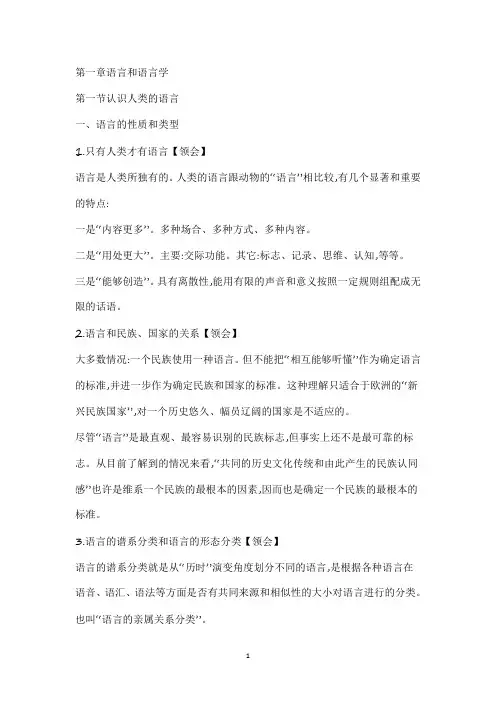
第一章语言和语言学第一节认识人类的语言一、语言的性质和类型1.只有人类才有语言【领会】语言是人类所独有的。
人类的语言跟动物的“语言”相比较,有几个显著和重要的特点:一是“内容更多”。
多种场合、多种方式、多种内容。
二是“用处更大”。
主要:交际功能。
其它:标志、记录、思维、认知,等等。
三是“能够创造”。
具有离散性,能用有限的声音和意义按照一定规则组配成无限的话语。
2.语言和民族、国家的关系【领会】大多数情况:一个民族使用一种语言。
但不能把“相互能够听懂”作为确定语言的标准,并进一步作为确定民族和国家的标准。
这种理解只适合于欧洲的“新兴民族国家”,对一个历史悠久、幅员辽阔的国家是不适应的。
尽管“语言”是最直观、最容易识别的民族标志,但事实上还不是最可靠的标志。
从目前了解到的情况来看,“共同的历史文化传统和由此产生的民族认同感”也许是维系一个民族的最根本的因素,因而也是确定一个民族的最根本的标准。
3.语言的谱系分类和语言的形态分类【领会】语言的谱系分类就是从“历时”演变角度划分不同的语言,是根据各种语言在语音、语汇、语法等方面是否有共同来源和相似性的大小对语言进行的分类。
也叫“语言的亲属关系分类”。
从语言的“共时”角度来划分不同的语言,可以建立“语言的形态分类”,也叫“语言的结构类型分类”。
可分为“形态语”和“孤立语”,或者分成“综合性语言”和“分析性语言”。
4.语系、语族;屈折语、孤立语;综合性语言、分析性语言【识记】谱系分类层级:语系、语族、(语支)、语言、方言、次方言(土语)。
语系是根据语言有无历史同源关系划分出来的语言类别,是语言谱系中最大的类。
语系的下一级叫作“语族”,同一语族的语言不但有相同的来源,相似点也更多。
形态语(综合性语言)指通过词的形态变化来体现各种结构意义的语言。
包括“屈折语、黏着语”等小类。
如俄语、维吾尔语。
孤立语(分析性语言)指没有形态变化的语言。
如汉语。
屈折语主要是句子中某些词本身有丰富的形态变化,是形态语中的一个小类。
![语言学纲要笔记,复习资料[1]](https://uimg.taocdn.com/823fd0ed7e21af45b307a8fb.webp)
导言1、语言学的三大发源地P1中国、印度、希腊—罗马是语言学的三大发源地。
2、传统语文学的构成部分P1文字、音韵。
训诂是我国传统语文学的构成部分,统称“小学”。
3、语言的构造P2语音、词汇和语义、语法三个部分4、语言交际的五个阶段P3编码——发送——传递——接收——编码5、语言学的概念以语言为研究对象的科学,研究探索语言的本质、结构和发展规律。
第一章语言的社会功能1、语言与言语的关系?言语是利用语言进行交际的行为和结果。
言语是个人的,语言是社会的;言语是具体的,语言是抽象的;言语是有阶级性的,语言是全民性的。
语言制约着言语,指导人们进行言语实践;语言存在于言语之中,存在于人们的交际过程之中,存在于言语行为和言语作品之中。
语言不能够脱离言语,言语也不能脱离语言,它们是不可分离的。
语言(language)和言语(parole)的区别是现代语言学奠基人索绪尔在《普通语言学教程》中提出的重要概念。
其区别表现在:第一,从运用角度来说,语言是社会共有的交际工具,相对稳定,语言是不自由的,有规则的,处于相对静止状态,语言是一个封闭的系统;言语是对语言的具体运用和由此产生的言语作品,是自由结合的,处于运用状态,言语始终是开放的。
第二,从表现形式看,语言是个音义结合的符号系统,人们要遵照这个系统的规则来使用它,是社会的,有共同性,也就是说语言属于全体社会成员;言语是人们运用语言的过程和结果,除了具有社会的因素外,还具有个人的因素,而且还要受某种特定语境的影响,从某种程度上来说,言语属于讲话者个人。
第三,语言的各个部分是有限的,抽象的;但言语是无限的,具体的。
联系表现在:第一,从历史上看,言语事实在先,规则在后,因此言语是第一性的,语言是第二性的。
哪里有言语,哪里就有语言;哪里没有言语,哪里就没有语言。
语言是存在于言语之中的,语言是从言语中抽象概括出来的模式,抽象的语言是不存在的,语言都是以言语的形式存在着的。
第二,语言来源于言语,又反作用于言语。
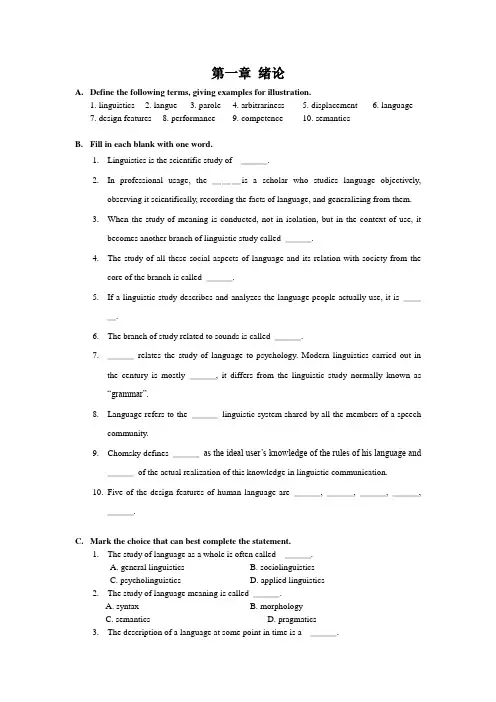
第一章绪论A.Define the following terms, giving examples for illustration.1. linguistics2. langue3. parole4. arbitrariness5. displacement6. language7. design features 8. performance 9. competence 10. semanticsB.Fill in each blank with one word.1.Linguistics is the scientific study of ___.2.In professional usage, the ___is a scholar who studies language objectively,observing it scientifically, recording the facts of language, and generalizing from them.3.When the study of meaning is conducted, not in isolation, but in the context of use, itbecomes another branch of linguistic study called ___.4.The study of all these social aspects of language and its relation with society from thecore of the branch is called ___.5.If a linguistic study describes and analyzes the language people actually use, it is ___.6.The branch of study related to sounds is called ___.7.___relates the study of language to psychology. Modern linguistics carried out inthe century is mostly ___, it differs from the linguistic study normally known as “grammar”.nguage refers to the ___linguistic system shared by all the members of a speechcommunity.9.Chomsky defines ___as the ideal user’s knowledge of the rules of his language and___of the actual realization of this knowledge in linguistic communication.10.Five of the design features of human language are ___, ___, ___, ___,___.C.Mark the choice that can best complete the statement.1.The study of language as a whole is often called ___.A. general linguisticsB. sociolinguisticsC. psycholinguisticsD. applied linguistics2.The study of language meaning is called ___.A. syntaxB. morphologyC. semanticsD. pragmatics3.The description of a language at some point in time is a ___.A. diachronicB. synchronicC. descriptiveD. prescriptive4.___made the distinction between langue and parole.A. ChomskyB. SapirC. HallD. Saussure5.Which of the following isn’t the design features of human language?A. ArbitrarinessB. PerformanceC. DualityD. Displacement6.Findings in linguistic studies can often be applied to the solution of some practicalproblems, the study of such applications is known as ___.A. anthropological linguisticsB. computational linguisticsC. applied linguisticsD. mathematical linguistics7.___refers to the abstract linguistic system shared by all the members of a speechcommunity.A. ParoleB. LangueC. SpeechD. Writing8.The definition “language is a purely human and non-instinctive method ofcommunicat ing ideas, emotions and desires by means of voluntarily produced symbols”was proposed by ___.A. SapirB. HallC. ChomskyD. Bloomfield9.The fact that different languages have different words for the same object is a goodillustration of the ___nature of language.A. arbitrarinessB. productivityC. dualityD. cultural transmission10.Which of the following isn’t a major branch of linguistics?A. PhonologyB. SyntaxC. PragmaticsD. SpeechD.Indicate the following statements true or false.1.Linguistics studies a particular language.nguage is an isolated phenomenon.3.The language a person uses often reveals his social background.nguage is human-specific.nguage is a complicated entity with multiple layers and facets, and it is possible forlinguists to deal with it all at once.6.The study of sounds used in linguistic communication is called phonetics.7.The study of all social aspects of language and its relation with society is calledsociolinguistics.8.Today, the grammar taught to learners of a language is basically prescriptive, so modernlinguistics is mostly prescriptive.9.In modern linguistics, synchronic study seems to enjoy priority over diachronic study.10.The distinction between langue and parole is the same as the distinction betweencompetence and performance.11.Linguists Sapir and Hall both treated language as a purely human institution.12.“lblk” is not a possible sound combination in English.参考答案:B. 1. language 2. linguist 3. pragmatics 4. sociolinguistics5.descriptive6. phonology7. psycholinguistics, descriptive8. abstract9. competence, performance 10. arbitrariness, productivity, duality, displacement,cultural transmissionC. 1-5ACBDB 6-10CBAADD. 1-5FFTTF 6-10TTFTF 11-12TT第二章音系学A.Define the following terms, giving examples if necessary:1.Phonetics2.Stops3.Voicing4.Allophone5.Suprasegmental features6.Phonology7.Tone8.Consonant9.Vowel10.Narrow transcriptionB.Indicate the following statements true or false:1.Of the media of language, writing is more basic than speech.2.There have been over 5,000 languages in the world, about two thirds of which have nothad written form.3.Speech sounds are limited in number.4.Of the three branches of phonetics, the longest established, and until recently the mosthighly developed, is acoustic phonetics.5.Sound [l] in the word leaf is a dark [\].6.Sound [p] in the word “spit” is an unaspirated stop.7.In English, all the front vowels and the central vowels are unrounded vowels.8.Phonology is interested in the system of sounds of a language; it aims to discover howspeech sounds form patterns and how they differ from each other.9.In English, the position of word stress distinguishes meaning.10.English is a typical tone language.11.Phonetics is of a general nature.12.Corresponding to the distinction of long and short vowels is the distinction of tense andloose vowels.C.Fill in each of following blanks.1.In linguistic evolution, ___prior to writing.2.The three branches of phonetics are: ___phonetics, ___phonetics and ___phonetics.3.The major suprasegmental features in English are: ______, ______and ___.4.The major rules in phonology are ___rule, ___rule, and ___rule.5.Clear [l] and dark [\] are the ___of the phoneme [l].6.Vibration of the vocal cords results in a quality of speech sounds called ___.7.The transcription with letter-symbols only is called _____, the transcription withdiacritics is called ______.8.In English these are two affricates, ___and ___.9.All the back vowels, with the exception of [a:], are ___.10.___can be simply defined as the speech sounds we use when speaking a language.D.Mark the choice that can best complete the statement:1.The ___is the most flexible, and is responsible for more varieties of articulationthan any other.A. lipsB. nasal cavityC. tongueD. oral cavity2.Liquids is classified in the light of ___.A. manner of articulationB. place of articulationC. place of tongueD. none of the above3.In English, there is only one glottal. It is ___.A. [l]B. [h]C. [k]D. [f]4.The phonetic symbol for “voiced, labiodental, fricative” is ___.A. [v]B. [d]C. [f]D. [m]5.The difference between [u] and [u:] is caused by ___.A. the openness of the mouthB. the shape of the lipsC. the length of the vowelsD. none of the above6.What kind of tone is used when what is said is a straight-forward, matter-of-factstatements?A. The rising toneB. The falling toneC. The fall-rise toneD. None of the above7.In a sentence, which of the following is usually not stressed?A. NounsB. Demonstrative pronounsC. Personal pronounsD. All of the above8.Which of the following is a typical tone language?A. EnglishB. ChineseC. FrenchD. All of the above9.Two allophones of the same phoneme are said to be in ___.A. phonemic contrastB. complimentary distributionC. minimal pairD. None of the above10.The sound [v] can be described as ___.A.voiced, labiodental, fricativeB.voiceless, labiodental, affricateC.voiced, alveolar, fricativeD.None of the above参考答案: A. 1-5 FTTFF 6-10TTFTF 11-12TF C. 1-5 CABAC 6-10 BCBBAB. 1. speech 2. articulatory, auditory, acoustic 3. word stress, sentence stress,intonation 4.sequential, assimilation, deletion 5. allophone 6. voicing 7. broadtranscription, narrow transcription 8. [] [] 9. rounded 10. Phone第3章形态学A.Decide whether each of the following statements is T (true) or F (false).()1. Morphology studies the internal structure of words and the rules by which words are formed.()2. Inflectional morphology is one of the two sub-branches of morphology.()3. The structure of words is not governed by rules.( ) 4. A morpheme is the basic unit in the study of morphology.( ) 5. Free morphemes are the same as bound morphemes.( ) 6. Sometimes bound morphemes can be used by themselves.( ) 7. There is only one type of affixes in the English language.( ) 8. Derivational affixes are added to an existing form to create a word.( ) 9. Compounding is the addition of affixes to stems to form new words.( ) 10. Phonetically, the stress of a compound always falls on the first element, while the second element receives secondary stress.B.Fill in each blank below with one word.1. __________ is the smallest meaningful unit of language.2. The affix "-es" conveys a __________ meaning.3. __________ morphemes are independent units of meaning and can be used freely all bythemselves.4. __________ affixes manifest various grammatical relations or grammatical categories such asnumber, degree, and case.5. The affixes occurring at the beginning of a word are called __________.6. The combination of two or sometimes more that two words to create new words is called__________7. Semantically, the meaning of a __________ is often idiomatic, not always being the sum totalof the meanings of its components.8. __________ morphology studies word-formation.9. A __________ can never stand by itself although it bears clears, definite meaning.10. __________ are added to the end of stems.C.There are four choices following each statement. Mark the choice that canbest complete the statement.( ) 1. The word "boyish" contains two ____________.A. phonemesB. morphsC. morphemesD. allomorphs( ) 2. Inflectional ____________ studies inflections.A. derivationB. inflectionC. phonologyD. morphology( ) 3. ____________ morphemes are those that cannot be used independently but have to be combined with other morphemes, either free or bound, to form a word.A. FreeB. BoundC. RootD. Affix( ) 4. ____________ modify the meaning of the stem, but usually do not change the part of speech of the original word.A. PrefixesB. SuffixesC. RootsD. Affixes( ) 5. There are rules that govern which affix can be added to what type of ____________to froma new word.A. rootB. affixC. stemD. word参考答案:A.1-5 TTFTF 6-10 FFTFTB. 1. Morpheme 2. grammatical 3. Free 4. Inflectional5. prefixes6. derivation7. compound8. Derivational9. root 10. SuffixesC.1-5 CDBAC第5章语义学A.Indicate the following statements T (true) or F (false).( ) 1. The conceptualist view holds that there is no direct link between a linguistic form and what it refers to (i.e. between language and the real world); rather, in the interpretation ofmeaning they are linked through the meditation of concepts in the mind.( ) 2. Sense and reference are two terms often encountered in the study of meaning.( ) 3. There are words with more or less the same meaning based in different regional dialects. ( ) 4. Componential analysis is based upon the belief that the meaning of a word can not be dissected into meaning components, called semantic features.( ) 5. One advantage of componential analysis is that by specifying the semantic features of certain words, it will be possible to show how these words are related in meaning. ( ) 6. Among the approaches to the study of meaning, the naming theory is better than others.( ) 7. Kid and child are stylistic synonyms.( ) 8. "furniture" is the superordinate of "bed".( ) 9. Antonyms contrast each other only on a single dimension, such as "live" and "die".( )10. "Cold" and "hot" are complementary antonyms.( )11. In English, there is no argument in some sentences.( )12.The sentence "Tom, smoke!" and "Tom smokes." have the same semantic predication. ( )13. The sentences that contain the same words are same in meaning.( )14. The meaning of a word is the combination of all its elements, and so is the sentence. ( )15. The meaning of the word we often use is the primary meaning.( )16. Meaning is central to the study of communication.( )17. The naming theory of meaning was proposed by the ancient Greek scholar Plato.( )18. In the classic semantic triangle, the symbol is directly related to the referent.( )19. Sense and reference are the same.( )20. Complete synonyms are rare in language.( )21. Stylistic synonyms differ in style because they come from different regions.( )22. Polysemy is the same as homonymy.( )23. Homophones are words which are identical in sound.( )24. The superordinate term is more general in meaning than its hyponyms.( )25. In a pair of gradable antonyms, the denial of one member of the pair implies the assertion of the other.( )26. In componential analysis, the plus sign is used to indicate that a certain semantic feature is present.( )27. The grammatical meaning of a sentence refers to its grammaticality.( )28. All the grammatically well-formed sentences are semantically well-formed.( )29. A predicate is something said about an argument.( )30. There is only one argument in the sentence "Kids like apples".B. Fill in each of the following blanks with one word.1.In semantic analysis, ___________ is the abstraction of the meaning of a sentence.2.___________ restrictions are constraints on what lexical items can go with what others.3.___________ analysis is based upon the belief that the meaning of a word can be divided intomeaning components4.___________ is a relation of inclusion.5.For ___________ antonyms, it is a matter of either one or the other.6.There are often intermediate form between the two members of a pair of ___________antonyms.7.The various meanings of a ___________ word are related to some degree.8.Synonyms which differ in the words they go together with are called___________synonyms.9.Linguistic forms having the same sense may have different ___________ in differentsituations.10.___________ is concerned with the inherent meaning of the linguistic form.11.___________ is based on the presumption that one can derive meaning from observablecontexts.12.There is no direct link between a linguistic form and what it refers to according to the___________ view.13.According to Wittgenstein, for a large class of cases, the meaning of a word is its___________ in the language.14.In the study of meaning, ___________ focus their interest on understanding the human mindthrough language.15.According to the ___________ theory of meaning, the words in a language are taken to belabels of the objects they stand for.16.Autumn and Fall are two ___________ ___________.17.The words of English are classified into ___________ words and ___________ words.18.Hyponymy is the relation of ___________, superordingate entails all ___________.19.“Father” and “son” are ___________ ___________.20.In the sentences of entailment, if X is true, Y is ___________.21.___________ is concerned with the inherent meaning of the linguistic form.22.___________ means what a linguistic form refers to in the real, physical world.23.The same one word may have more that one meaning, this is what we called ___________,and such a word is called ___________ word.24.___________ refers to the sense relation between a more general, more inclusive word and amore specific word.25.In semantic analysis of a sentence, the basic unit is called ___________.C.Mark the choice that can best complete the statement:( ) 1. “Lorry” and “truck” are ____________.A. dialectal synonymsB. stylistic synonymsC. synonyms that differ in their emotive meaningD. none of the above( ) 2. Which pair is the emotive synonyms ____________.A. dad, fatherB. flat, apartmentC. mean, frugalD. charge, accuse( ) 3. In the collocational synonyms, "rebuke" is collocated by ____________.A. withB. forC. ofD. against( ) 4. The noun tear and the verb tear are ____________.A. homophonesB. homographsC. complete homonymsD. none of the above( ) 5. The sentence John likes ice-cream contains ____________ arguments.A. oneB. twoC. noneD. three( ) 6. The classic semantic triangle reflects ____________.A. the naming theoryB. the conceptual viewC. the contextualist viewD. the behaviorist view( ) 7. ____________ concerns with the inherent meaning of the linguistic form; it's abstract and de-contextualized.A. ReferenceB. SemanticC. SenseD. none of the above( ) 8. The same word may have more than one meaning, which is called ____________.A. synonymyB. homonymyC. hyponymyD. polysemy( ) 9. ____________ analysis is a way to analyze sentence meaning.A. ComponentialB. PredicationC. SyntacticD. none of the above( )10. Whether a sentence is semantically meaningful is governed by rules called ____________.A. selectional restrictionsB. grammatical rulesC. phrase structure rulesD. all of the above( ) 11. Semantics can be defined as the study of ____________.A. namingB. meaningC. communicationD. context( ) 12. In the study of meaning, the ____________ are interested in understanding the relations between linguistic expressions and what they refer to in the real world.A. linguistsB. philosophersC. psychologistsD. phoneticians( ) 13. The linguistic ____________ is sometimes known as co-text.A. contextB. situationC. contextualizationD. situation of context( ) 14. Bloomfield drew on _____________ psychology when trying to define the meaning of linguistic forms.A. contextualB. conceptualistC. behavioristD. naming( ) 15. Sense and reference are two related ______________ different aspects of meaning.A. butB. andC. orD. as well as( ) 16. ____________ means what a linguistic form refers to in the real, physical world.A. SenseB. ReferenceC. MeaningD. Semantics( ) 17. Dialectal synonyms are synonyms used in different ____________ dialects.A. personalB. regionalC. socialD. professional( ) 18. Hyponyms of the same ____________ are co-hyponyms.A. wordB. lexical itemC. superordinateD. hyponymy( ) 19. Words that are opposite in meaning are ____________.A. synonymsB. hyponymsC. antonymsD. homophones( ) 20. An ____________ is a logical participant in a predication.A. argumentB. predicateC. predicationD. agentD. Define the following terms, giving examples for illustration.1. semantics2. the naming theory3. superordinate4. complete homonym5. hyponymy参考答案:A. 1-5 TTTFT 6-10 FFTFF 11-15 TTFFF 16-20 TTFFT21-25 FFTTF 26-30 TTFTFB. 1. predication 2. Selectional 3. componential 4. Entailment5. complementary6. gradable7. polysemic8. collocational9. references 10. Sense 11. Contextualization 12. conceptualist13. use 14. psychologists 15. naming 16. stylistic synonyms17. native, loan 18. entailment, hyponyms 19. relational opposites20. true 21. Sense 22. Reference 23. polysemy, polysemic24. Hyponymy 25. predicationC. 1-5 ACBBB 6-10 BCDBA 11-15 BBACA 16-20 BBCCA第6章语用学A.Decide whether each of the following statements is T (true) or F (false). ( ) 1. The contextualist view is often considered as the initial effort to study meaning in a pragmatic sense.( ) 2. Pragmatics is related to and also different from semantics.( ) 3. The notion of context is not important to the pragmatic study of language.( ) 4. All utterances take the form of sentences.( ) 5. Speech act theory was proposed by the British philosopher John Austin in the late 1950s ofthe 20th century.( ) 6. Grice made a distinction between what he called "constatives" and "performatives". ( ) 7. A locutionary act is the act of conveying literal meaning by means of syntax, lexicon, and phonology.( ) 8. In their study of language communication, linguists are only interested in how a speaker expresses his intention and pay no attention to how his intention is recognized by thehearer.( ) 9. Directives are attempts by the speaker to get the hearer to do something.( ) l0. The Cooperative Principle was proposed by John Searle.( ) 11. There are four maxims under the Cooperative Principle.( ) 12. The violations of the maxims make our language indirect.( ) 13. All the utterances take the form of sentences.( ) 15. According to the speech act theory, when we are speaking a language, we are doing something, or in other words performing acts; and the process of linguisticcommunication consists of a sequence of acts.( ) 16. All the acts that belong to the same category of illocutionary act share the same purpose or the same illocutionary act, and they are the same in their strength or force.( ) 17. All the utterances that can be made to serve the same purpose may vary in the syntactic form.( ) 18. Conversation participants nearly always observe the CP and the maxims of the CP. ( ) 19. A sentence is a grammatical concept, and the meaning of a sentence is often studied as the abstract intrinsic property of the sentence itself in terms of a predication.( ) 20. Utterance is based on sentence meaning, it is the realization of the abstract meaning of a sentence in a real situation of communication or simply in a context.( ) 22. As the process of communication is essentially a process of conveying meaning in a certain context, pragmatics can also be regarded as a kind of meaning study.( ) 23. Gradually linguists found that it would be impossible to give an adequate description of meaning if the context of language use was left unconsidered.( ) 24. What essentially distinguishes semantics and pragmatics is whether in the study of meaning the context of use is considered.( ) 25. Without the shared knowledge both by the speaker and the hearer, linguistic communication would not be possible, and without considering such knowledge,linguistic communication cannot be satisfactorily accounted for in a semantic sense. ( ) 26. An perlocutionary act is the act of expressing the speaker's intention.( ) 27. According to Paul Grice's idea, in making conversation, the participants must first of all be willing to cooperate, otherwise, it would not be possible for them to carry on the talk. ( ) 28. An illocutionary act is the consequence of or the change brought about by the utterance.B. Fill each of the following blanks with one word.1. The shared knowledge which constitutes context is of two types; the knowledge of the _____they use, and the knowledge about the _____, including the general knowledge aboutthe word and specific knowledge about the situation in which linguistic communicationis taking place.2. If we think of a sentence as what people actually utter in the course of communication, itbecomes an _____, and it should be considered in the situation in which it is actuallyused.3. The idea of Paul Grice is that in making conversation, the participants must first of all bewilling to _____; otherwise, if would be impossible for them to carry on the talk. Thegeneral principle is called the ______ ______, abbreviated as CP.4. There are four maxims under the CP: the maxim of quantity, the maxim of ______, themaxim of relation and the maxim of ______.5. The maxim of relation requires that what the conversation participants say must be ______.6. As the process of communication is essentially a process of conveying meaning in a certaincontext, ______can be regarded as a kind of meaning study.7. If ______ is not considered, the study of meaning is restricted to the area of traditionalsemantics.8. The meaning of an _______is concrete and context-dependent.9. An ______ is not considered, the study of meaning is restricted to the area of traditionalsemantics.10. According to Searle, ______ acts fall into five general categories.11. ______ are those speech acts whose point is to commit the speaker to some future course ofaction.12. To ask someone to pass a book is obviously a ______.13. According to Paul Grice, in making ______, the participants must first of all be willing tocooperate.14. Most of the violations of the four maxims give rise to ______ implicatures.15. The significance of Grice’s ______ Principle lies in that it explains how it is possible for thespeaker to convey more than is literally said.C.There are four choices following each statement. Mark the choice that can best complete the statement.( ) 1. __________ resulted mainly from the expansion of the study of linguistics, especially that of semantics.A. PragmaticsB. PragmatismC. PhonologyD. Practicalism( ) 2. Once the notion of __________ was taken into consideration, semantics spilled into pragmatics.A. meaningB. contextC. formD. content( ) 3. If a sentence is regarded as what people actually utter in the course of communication, it becomes __________.A. a sentenceB. an actC. a unitD. an utterance( ) 4. A __________ analysis of an utterance will reveal what the speaker intends to do with it.A. semanticB. syntacticC. pragmaticD. grammatical( ) 5. __________ act theory is an important theory in the pragmatic study of language.A. SpeakingB. SpeechC. SoundD. Spoken( ) 6. __________ act is the act performed by or resulting from saying something.A. A locutionaryB. An illocutionaryC. A perlocutionaryD. A speech( ) 7. One of the contributions Searle has made is his classification of __________ acts.A. IocutionaryB. illocutionaryC. perlocutionaryD. speech( ) 9. All the utterances that can be made to serve the same purpose may vary in their __________ form.A. syntacticB. semanticC. grammaticalD. pragmatic( ) 10. The Cooperative Principle is proposed by __________.A. John SearleB. John AustinC. Paul GriceD. John Lyons( ) 11. Linguists found that it would be impossible to give an adequate description of meaning if the __________ of language use was left unconsidered.A. brevityB. contextC. accuracyD. none of the above( ) 12. Of the three speech acts, linguists are most interested in the __________.A. locutionary actB. perlocutionary actC. illocutionary actD. none of the above( ) 13. The maxim of quantity requires: __________A. make your contribution as informative as required.B. do not make contribution more informative than is required.C. do not say that for which you lack adequate evidence.D. Both A and B.( ) 14. The maxim of quality requires: do not say what you believe to be __________.A. falseB. trueC. briefD. orderly( ) 15. Most of the violations of the maxims of the CP give rise to __________.A. utterance meaningB. speech act theoryC. conversational implicatureD. all of the above( ) 16. The significance of Grice's CP lies in that it explains how it is possible for the speaker to convey __________ is literally said.A. more thanB. less thanC. the same asD. none of the aboveD. Define the following terms, giving examples for illustration:1. context2. utterance meaning3. locutionary act4. illocutionary act5. perlocutionary art参考答案:A. 1-5 TTFFT 6-10 FTFTF 11-16 TTFTT 16-20 FTFTT 21-25 FTFTF 26-28 FTFB. 1. language, world 2. utterance 3. cooperate, Cooperative Principle4. quality, manner5. relevant6. pragmatics7. context8. utterance 9. illocutionary 10. speech 11. Commissives12. directive 13. conversation 14. conversational 15. CooperativeC. 1-5ABDCB 6-10 CBCAC 11-15 BCDAC 16 A。
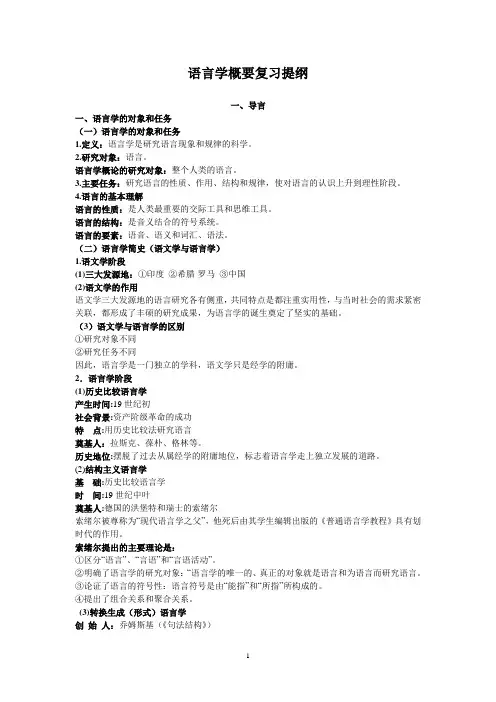
语言学概要复习提纲一、导言一、语言学的对象和任务(一)语言学的对象和任务1.定义:语言学是研究语言现象和规律的科学。
2.研究对象:语言。
语言学概论的研究对象:整个人类的语言。
3.主要任务:研究语言的性质、作用、结构和规律,使对语言的认识上升到理性阶段。
4.语言的基本理解语言的性质:是人类最重要的交际工具和思维工具。
语言的结构:是音义结合的符号系统。
语言的要素:语音、语义和词汇、语法。
(二)语言学简史(语文学与语言学)1.语文学阶段(1)三大发源地:①印度②希腊-罗马③中国(2)语文学的作用语文学三大发源地的语言研究各有侧重,共同特点是都注重实用性,与当时社会的需求紧密关联,都形成了丰硕的研究成果,为语言学的诞生奠定了坚实的基础。
(3)语文学与语言学的区别①研究对象不同②研究任务不同因此,语言学是一门独立的学科,语文学只是经学的附庸。
2.语言学阶段(1)历史比较语言学产生时间:19世纪初社会背景:资产阶级革命的成功特点:用历史比较法研究语言奠基人:拉斯克、葆朴、格林等。
历史地位:摆脱了过去从属经学的附庸地位,标志着语言学走上独立发展的道路。
(2)结构主义语言学基础:历史比较语言学时间:19世纪中叶奠基人:德国的洪堡特和瑞士的索绪尔索绪尔被尊称为“现代语言学之父”,他死后由其学生编辑出版的《普通语言学教程》具有划时代的作用。
索绪尔提出的主要理论是:①区分“语言”、“言语”和“言语活动”。
②明确了语言学的研究对象:“语言学的唯一的、真正的对象就是语言和为语言而研究语言。
③论证了语言的符号性:语言符号是由“能指”和“所指”所构成的。
④提出了组合关系和聚合关系。
(3)转换生成(形式)语言学创始人:乔姆斯基(《句法结构》)主要观点:认为语言描写和分析的目的不在于分类,而在于建立一种理论,在于研究人的语言生成能力,即怎样用有限的成分和规则生成无限的句子。
理论构成:主要包括生成规则和转换规则两部分。
①生成规则包括一套短语结构规则和词汇插入规则。
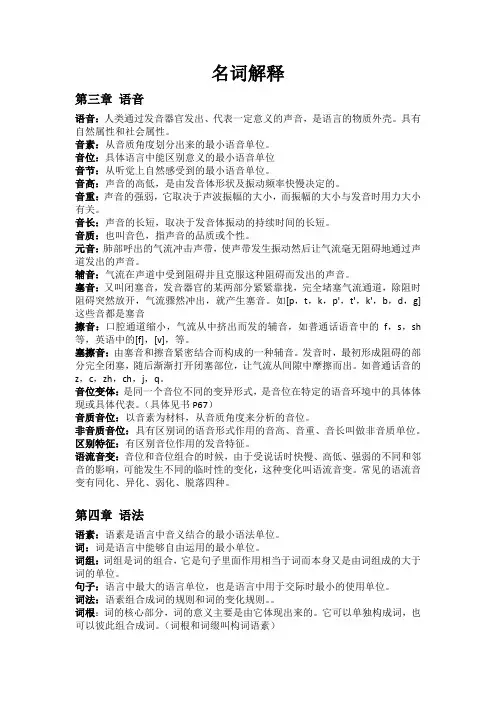
名词解释第三章语音语音:人类通过发音器官发出、代表一定意义的声音,是语言的物质外壳。
具有自然属性和社会属性。
音素:从音质角度划分出来的最小语音单位。
音位:具体语言中能区别意义的最小语音单位音节:从听觉上自然感受到的最小语音单位。
音高:声音的高低,是由发音体形状及振动频率快慢决定的。
音重:声音的强弱,它取决于声波振幅的大小,而振幅的大小与发音时用力大小有关。
音长:声音的长短,取决于发音体振动的持续时间的长短。
音质:也叫音色,指声音的品质或个性。
元音:肺部呼出的气流冲击声带,使声带发生振动然后让气流毫无阻碍地通过声道发出的声音。
辅音:气流在声道中受到阻碍并且克服这种阻碍而发出的声音。
塞音:又叫闭塞音,发音器官的某两部分紧紧靠拢,完全堵塞气流通道,除阻时阻碍突然放开,气流骤然冲出,就产生塞音。
如[p,t,k,p',t',k',b,d,g]这些音都是塞音擦音:口腔通道缩小,气流从中挤出而发的辅音,如普通话语音中的f,s,sh 等,英语中的[f],[v],等。
塞擦音:由塞音和擦音紧密结合而构成的一种辅音。
发音时,最初形成阻碍的部分完全闭塞,随后渐渐打开闭塞部位,让气流从间隙中摩擦而出。
如普通话音的z,c,zh,ch,j,q。
音位变体:是同一个音位不同的变异形式,是音位在特定的语音环境中的具体体现或具体代表。
(具体见书P67)音质音位:以音素为材料,从音质角度来分析的音位。
非音质音位:具有区别词的语音形式作用的音高、音重、音长叫做非音质单位。
区别特征:有区别音位作用的发音特征。
语流音变:音位和音位组合的时候,由于受说话时快慢、高低、强弱的不同和邻音的影响,可能发生不同的临时性的变化,这种变化叫语流音变。
常见的语流音变有同化、异化、弱化、脱落四种。
第四章语法语素:语素是语言中音义结合的最小语法单位。
词:词是语言中能够自由运用的最小单位。
词组:词组是词的组合,它是句子里面作用相当于词而本身又是由词组成的大于词的单位。
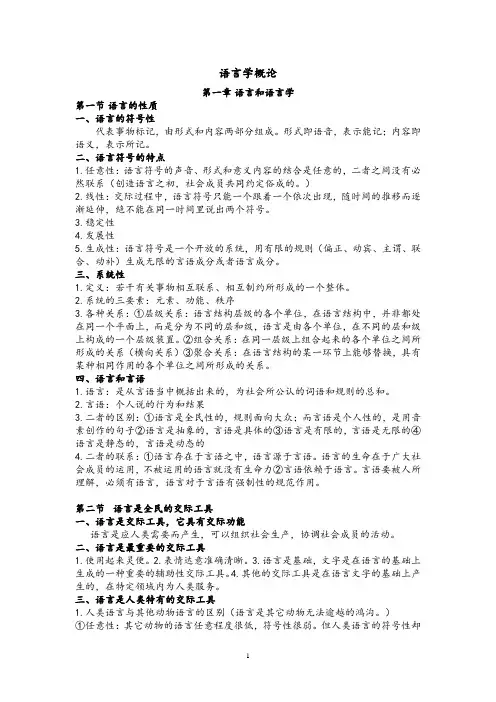
语言学概论第一章语言和语言学第一节语言的性质一、语言的符号性代表事物标记,由形式和内容两部分组成。
形式即语音,表示能记;内容即语义,表示所记。
二、语言符号的特点1.任意性:语言符号的声音、形式和意义内容的结合是任意的,二者之间没有必然联系(创造语言之初,社会成员共同约定俗成的。
)2.线性:交际过程中,语言符号只能一个跟着一个依次出现,随时间的推移而逐渐延伸,绝不能在同一时间里说出两个符号。
3.稳定性4.发展性5.生成性:语言符号是一个开放的系统,用有限的规则(偏正、动宾、主谓、联合、动补)生成无限的言语成分或者语言成分。
三、系统性1.定义:若干有关事物相互联系、相互制约所形成的一个整体。
2.系统的三要素:元素、功能、秩序3.各种关系:①层级关系:语言结构层级的各个单位,在语言结构中,并非都处在同一个平面上,而是分为不同的层和级,语言是由各个单位,在不同的层和级上构成的一个层级装置。
②组合关系:在同一层级上组合起来的各个单位之间所形成的关系(横向关系)③聚合关系:在语言结构的某一环节上能够替换,具有某种相同作用的各个单位之间所形成的关系。
四、语言和言语1.语言:是从言语当中概括出来的,为社会所公认的词语和规则的总和。
2.言语:个人说的行为和结果3.二者的区别:①语言是全民性的,规则面向大众;而言语是个人性的,是用音素创作的句子②语言是抽象的,言语是具体的③语言是有限的,言语是无限的④语言是静态的,言语是动态的4.二者的联系:①语言存在于言语之中,语言源于言语。
语言的生命在于广大社会成员的运用,不被运用的语言就没有生命力②言语依赖于语言。
言语要被人所理解,必须有语言,语言对于言语有强制性的规范作用。
第二节语言是全民的交际工具一、语言是交际工具,它具有交际功能语言是应人类需要而产生,可以组织社会生产,协调社会成员的活动。
二、语言是最重要的交际工具1.使用起来灵便。
2.表情达意准确清晰。
3.语言是基础,文字是在语言的基础上生成的一种重要的辅助性交际工具。
语言学Linguistic各章重点,学习资料整理1.1What is language?Language is a system of arbitrary vocal symbols used for human communication.1.2Design features of language①Arbitrariness任意性:The property of language by which there is in general no natural (i。
e。
logical)relation between the form of a single lexical unit and its meaning。
②Duality二重性Language consists of two levels of structures. The lower (secondary)level is a definite set of meaningless sounds, which combine to form meaningful units which constitute a higher (primary) level。
③Creativity创造性Language is creative in the sense that its users can understand and produce sentences they have never heard before。
④Displacement移位性By displacement is meant that language can be used to refer to things that are not present (in time and space)at the moment of communication。
1.3Functions of language①Informative信息功能Language serves an informative function when it is used to express the speaker’s opinion, to state a fact,or to reason things out。
语言学概论(邢福义)复习提纲一、名词解释(1)能指与所指用甲事物代表乙事物,而甲乙两事物之间没有必要的联系,甲事物就是乙事物的符号。
其中甲事物就是符号的能指(形式),乙事物就是符号的所指(内容、意义)。
二者关系是人为约定的。
(2)语言与言语广义的语言包括语言系统、言语活动和言语作品,狭义的语言只指语言系统,而言语则包括言语活动和言语作品。
语言系统包括语音、语义、语汇、语法四个子系统。
言语活动是语用语汇材料和语法规则交流思想的活动,简言之就是说话。
(3)组合关系和聚合关系若干较小的语言单位组合成较大的语言单位,其构成成分之间的关系就是组合关系,又称线性序列关系;具有相同组合功能的语言单位之间的关系就是聚合关系,又称联想关系。
(4)词法类型和句法类型从词法的角度给语言划分出的类型叫语言的词法类型,又叫形态类型,一般分为四种:词根语、屈析语、粘着语、编插语;从句法的角度给语言分类叫语言的句法分类。
语言的句法分类最常见的是根据句子的基本成分主语(S)、动词(V)、宾语(O)在简单陈述句中的位置来分类,一般分为SVO,SOV,VSO三种类型语言。
(5)内部语言学与外部语言学内部语言学又称为本体语言学或微观语言学,它主要研究语言的内部结构。
外部语言学又称宏观语言学或边缘语言学。
它主要研究语言与其他相关现象的关系。
(6)音质音质指声音的性质、特色,它是语音最重要的属性。
其变化决定于:发音体,发音方法,共鸣器形状。
(7)音系学是对语言的语音系统的研究。
它从语言的社会功能出发,把许多从生理和物理角度分析出来的不同的语音单位归纳成数目有限的、有辨义作用的语音单位——音位。
(8)实验语音学20世纪20年代以后逐渐形成和发展的一个语音研究的分支学科。
使用实验仪器或电子计算机对语音的各种特性进行实验研究,研究对象涉及语音的各个方面,研究手段和方法涉及多门学科,是一门综合性的边缘学科。
(9)音素与音位音素是人类语言从音质角度划分出来的最小的语音单位。
语言学概论复习第一章语言是什么第一节语言是一种声音一、语言是一种声音二、这种声音是人有意识地从发音器官发出的三、这种声音能代表一定的客观现象四、这种声音能分解和组合,这些分解和组合是有规律可寻的第二节语言与说话一、语言不等于说话二、语言是说话所用的材料和规则,语言是抽象的,是全社会一致的三、说话也叫“言语”。
言语是对材料和规则的具体运用,是可感知的,是因人而异的四、语言是通过一定的可感知形式来传递一定信息的符号系统┌听觉语符——音符(语音)┌可感知形式——语符┤│└视觉语符——文字(?)语言┤│┌语汇(词汇)└信息(内容)——语义┤└语法传统上语音、词汇、语法合称语言三要素。
第三节语言的功能一、语言是人类最重要的交际工具(一)人类有多种交际工具:(二)这些都比不上语言重要。
二、语言是人类最重要的思维工具(一)人类左半脑掌管与语言有关的抽象思维;右半脑掌管与语言无关的形象思维(二)抽象思维是否一定要语言参与(三)语言只是一种符号,是一种替代品,人们能利用语言进行思维,也应该可以利用其它的替代品进行思维。
(四)人类有了语言之后主要依靠语言进行思维第四节语言是符号系统一、什么是符号(一)符号就是用一种东西(甲)来代替另外一种东西(乙),通常是用具体的、浅显的、通俗的来代替抽象的、深奥的、孤僻的。
(二)语言也是一种符号,是听觉符号(三)语言符号的特点1.约定俗成(任意性)2.线性(四)符号与客观二、语言的层级体系(一)层级体系的构成(二)语言层级体系的特点:三、组合关系和聚合关系(一)组合关系(二)聚合关系第五节语言系统是人类特有的一、语言能力需要具备的条件(一)生理条件:一定的大脑容量,使之具备抽象、概括能力(二)心理条件:听觉系统和发音器官(三)社会条件:即到了有什么非说不可的地步二、其它动物不具备语言条件第二章语言学第一节什么是语言学语言学是以语言为研究对象的一门科学。
第二节语言学的简要历史一、人类早期关于语言的神话传说二、语言学问题的哲学探讨三、语言研究的语文学阶段(一)中国的语文学研究(二)印度的语文学研究(三)古希腊罗马的语文学研究四、传统语言学五、现代语言学(一)历史比较语言学(二)结构主义语言学(三)转换-生成语言学第三节语言学的分类一、微观语言学和宏观语言学(一)微观语言学研究语言本身。
自考《现代语言学》复习讲义一、常考题型1.填空2.单项选择3.判断正误4.解释词语并举例说明对名词解释并举一两个例子进行说明5.回答问题做题要求:用英文进行答题。
二、各章节学习要点Chapter 1 Introduction (绪论)is linguisticsDefinition (语言学的定义)Linguistics is generally defined as the scientific study of language.Linguistics studies not any particular language, ., English, Chinese, Arabic, and Latin, but in language in general.The Scope of linguistics (语言学的研究范畴)—4The study of language as a whole is often called general linguistics(普通语言学).This deals with the basic concepts, theories, descriptions, models and methods applicable in any linguistic study, in contrast to those branches of study which relate linguistics tothe research of other areas.Main branches of linguistics 语言学的主要分支:1)phonetics(语音学) 2)phonology (音系学) 3)morphology (形态学) 4)syntax (句法学) 5)semantics (语义学) 6)pragmatics (语用学)The study of all these aspects of language forms the core of linguistics.Findings in linguistic studies can often be applie3d to the solution of such practical problems as the recovery of speech ability. The study of such applications is generally known as applied linguistics.Macrolinguistics 宏观语言学:1) Psycholingusitcs (心理语言学);2) Sociolinguistics (社会语言学);3) Anthropological linguistics (人类语言学);4) Computational linguistics (计算语言学)Some important distinctions in linguistics —71.3.1 Prescriptive vs. descriptive (规定性和描述性)Modern linguistics, ., linguistic study carried out in this century is mostly descriptive.1.3.2 Synchronic vs. diachronic (共时性和历时性)In modern linguistics, synchronic study seems to enjoy priority over diachronic study.1.3.3 Speech and writing (口头语和书面语)Speech and writing are the two major media of communication. Modern linguistics regards the spoken language as primary, not the written.1.3.4 Langue and parole (语言和言语)The distinction between langue and parole was made by the Swiss linguist F. de Saussure in the early 20th century.1.3.5 Competence and performance (语言能力和语言运用)Similar to Saussure’s distinction between langue and parole is the distinction between competence and performance, which was proposed by the American linguist N. Chomsky in the late 1950’s.While Saussure’s distinction and Chomsky’s are very similar, they differ at least in that Saussure took a sociological view of language and his notion of langue is a matter of social conventions, and Chomsky looks at language from a psychological point of view and to him competence is a property of the mind of each individual.2. What is languageDefinitions of languageLanguage is a system of arbitrary vocal symbols used for human communication.(语言是人类在交际中使用的一套任意的声音符号系统。
《语言学概论》笔记及复习重点一、名词解释:历史语言学:主要用历史的方法研究某种语言的短期的和长期的变化规律,如汉语史、英语史。
共时语言学:研究语言在某一时期的相对静止的情况,如现代汉语。
普通语言学:研究对象是人类语言,着重从理论上探讨语言的共同特点和一般规律,也叫一般语言学。
隐性意义:指隐藏在显性意义后面的各种语法关系,通常表现为施事与动作,动作与受事的关系等。
隐性形式:从微观角度看,句法结构的外部形式具有层次性。
这种层次性不能从外表一眼看出来,需要我们从小到大或从大到小地分析。
显性形式:从宏观上看,句法结构外部形式是线条性,我们把它叫显性形式。
语言学:是研究语言的科学。
语言学家研究的只是经过语言学家主观概括和不同程度上理想化和简单化了的语言。
符号:指的是根据社会的约定俗成使用某种特定的物质实体来表示某种特定的意义而形成的这种实体和意义的结合体。
“符号”必然包括有任何情况下永远不可分割的两个方面,一个方面是物质的实体,另一个方面是约定俗成的意义。
“能指”:是索绪尔给语言符号的物质实体创制的一个专门的术语。
也就是能够指称某种意义的成分。
“所指”:是索绪尔给符号所指的意义内容创制的一个专门术语,也就是“能指成分”,即特定的物质实体,所指的意义内容。
语音:虽是一种声音,但又与一般的声音有着本质的区别。
它是由人的发音器官发出的,负载着一定的意义,并作为语言符号系统载体的声音。
音素:是从音质角度划分出来的最小语音单位。
根据音质的不同,对一串语音不断加以切分,直到不能切分为止,这样得到的语音就是“音素”。
标写语音的书面符号叫做“音标”。
“音位”:就是从社会功能的角度划分出来的语音单位,它是特定语言或方言中具有区别意义作用的最小的语音单位。
“音质音位”和“非音质音位”:音位从构成材料上看,可以分为音质音位和非音质音位。
以音素为材料,通过音质的差别来起辨义作用的音位叫“音质音位”。
语音中除音质外,音高、音强、音长也能起这种作用,因此也构成音位。
《语言学教程》重难点学习提示第一章语言的性质语言的定义:语言的基本特征(任意性、二重性、多产性、移位、文化传递和互换性);语言的功能(寒暄、指令、提供信息、询问、表达主观感情、唤起对方的感情和言语行为);语言的起源(神授说,人造说,进化说)等。
第二章语言学语言学定义;研究语言的四大原则(穷尽、一致、简洁、客观);语言学的基本概念(口语与书面语、共时与历时、语言与言学、语言能力与言行运用、语言潜势与语言行为);普通语言学的分支(语音、音位、语法、句法、语义);;语言学的应用(语言学与语言教学、语言与社会、语言与文字、语言与心理学、人类语言学、神经语言学、数理语言学、计算语言学)等。
第三章语音学发音器官的英文名称;英语辅音的发音部位和发音方法;语音学的定义;发音语音学;听觉语音学;声学语音学;元音及辅音的分类;严式与宽式标音等。
第四章音位学音位理论;最小对立体;自由变异;互补分布;语音的相似性;区别性特征;超语段音位学;音节;重音(词重音、句子重音、音高和语调)等。
第五章词法学词法的定义;曲折词与派生词;构词法(合成与派生);词素的定义;词素变体;自由词素;粘着词素(词根,词缀和词干)等。
第六章词汇学词的定义;语法词与词汇词;变词与不变词;封闭词与开放词;词的辨认;习语与搭配。
第七章句法句法的定义;句法关系;结构;成分;直接成分分析法;并列结构与从属结构;句子成分;范畴(性,数,格);一致;短语,从句,句子扩展等。
第八章语义学语义的定义;语义的有关理论;意义种类(传统、功能、语用);里奇的语义分类;词汇意义关系(同义、反义、下义);句子语义关系。
第九章语言变化语言的发展变化(词汇变化、语音书写文字、语法变化、语义变化);第十章语言、思维与文化语言与文化的定义;萨丕尔-沃夫假说;语言与思维的关系;语言与文化的关系;中西文化的异同。
第十一章语用学语用学的定义;语义学与语用学的区别;语境与意义;言语行为理论(言内行为、言外行为和言后行为);合作原则。
Invitations to Linguistics1.Give definitions for the following terms:arbitrariness metalanguage phatic communion2.Answer the following questions briefly.1) Is modern linguistics mainly synchronic or diachronic? Why?2) How is Saussure’s distinction between langue and parole similar to Chomsky’s distinction between competence and performance? How are they different from each other?3) “As the night fell, the wind rose.” Could this sentence be expressed “As the wind rose, the night fell”? If not, why? Does this indicate a non-arbitrariness about word order?4)Does the traffic light system have duality, why?5)Is the fact that linguistic signals do not normally serve any other type of purpose, such as feeding, a good reason to consider this (signaling) a unique property of human language?6) List five major functions of language and explain what they mean respectively.Chapter 2 Phonetics1.Answer the following questions briefly.1)Give a brief introduction to phonetics.2)Which of the following words end with voiceless (-V) sounds and which endwith voiced (+V) sounds?A) crash B) bang C) smackD) thud E) wham F) splat3)How do the words surface and service differ phonetically?4) Give 2 examples for each of the following terms:voiced Soundsvoiceless Soundsplosivesfront vowelsdiphthongsNotes: Please remember the Table 2.1 on page 44 and Table 2.3 on page 52.Chapter 3 Phonology3.Give definitions for the following terms:phoneme allophone minimal pairs syllable4.Answer the following questions briefly.1)How are phonetics and phonology related to and different from each other?2)Which segments are most likely to be affected by elision in the pronunciationof the following words?A) postman B) government C) sandwich D) pumpkin3) Mary is washing the dishes. Write 3 different stresses for the sentence andexplain the difference in meaning.4) What’s the difference between an open and a closed syllable?Chapter 4 Words and word-formation processes1.Define the following terms:Lexeme derivation inflection affix loanword acronymment on the following viewpoint briefly: Word is a minimum free form.3. List five word-formation processes.3.Give five examples of onomatopoeic words.4.Give five examples of acronyms.5. Give an inflectional ending to the following words:table open whisper stand book6. Change the word class of the following words using derivations:short prison wise play help7. Give the abbreviations for the following words:advertisementbicyclemathematicsprofessorinformationminivanChapter 5 Morphology1. Define the following terms:morphology morpheme free morpheme bound morpheme allomorph2.List the bound morphemes to be found in these words:misleads; previewer, shorten3. Add an inflectional affix to the following words:run display manage flower part3.Draw a tree diagram to show the relationship among the following terms.morpheme, free morpheme, bound morpheme, bound root, affix, derivational morpheme, inflectional morphemeChapter 6 Syntax1. Define or explain the following terms:syntax, immediate constituent analysis, FSP5.Change the following sentences to be less ambiguous:i.The man is too heavy to move.ii.Flying planes can be dangerous.6.Who distinguished syntagmatic and paradigmatic relations? What do they refer torespectively?7.Who put forward the IC analysis? List two problems in IC analysis.8.Who is the most important advocator of transformational-generative grammar?Why is it named transformational-generative grammar?9.IC analysis.Chapter 7 Semantics1. Define or explain the following terms:semantics conceptual meaning reference synonymy antonymy homonymy hyponymy2.Give a brief introduction to the classic semantic triangle.3.Explain the phenomenon of semantic ambiguity with examples.4.What is antonymy? What are the three major types of antonyms?5.What is the basic lexical relation between the following pairs of words?a. shallow deepb. mature ripec. . table furnitured. single marriede. move run(a. antonymy; b. synonymy; c. hyponymy; d. antonymy; e. hyponymy)Chapter 8 Pragmatics1.How is pragmatics related to and different from semantics?2.Which maxim of CP is violated/flouted respectively in the followingconversations?A: Would you like to come to our party tonight?B: I’m afraid I’m not feeling so well today.A: The hostess is an awful bore. Don’t you think?B: The roses in the garden are beautiful, aren’t they?3.If you ask somebody “Can you open the door?”, he answers “Y es” but does notactually do it, what would you be your reaction? Why? Try to see it in the light of speech act theory.4.What is speech act theory? Give examples to demonstrate it.5.What is CP? How does the violation of its maxim give rise to conversationalimplicatures?Chapter 9 Language, culture and thought1.What is sociolinguistics? When did it become an independent branch oflinguistics?ment on the following sentences: Language marks our identity./ “You arewhat you say.”3.Explain with examples language sexism/linguistic sexism.4.Give an introduction to the Sapir-Whorf hypothesis.5.What is, in your opinion, the relationship between culture and language? Explainyour viewpoint with examples.。